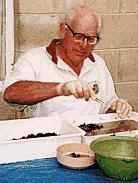 The following section is a description
of Dr. Clarke's study of beaks from the stomach of a sperm whale
stranded recently to the north of Kaikoura.
The following section is a description
of Dr. Clarke's study of beaks from the stomach of a sperm whale
stranded recently to the north of Kaikoura.
![]() A great profile of Dr. Clarke, including wonderful photographs is available on the National Geographic Society's Kaikoura Web Site. Be sure to take a look at Dr. Clarke's entry in the Crew section.
A great profile of Dr. Clarke, including wonderful photographs is available on the National Geographic Society's Kaikoura Web Site. Be sure to take a look at Dr. Clarke's entry in the Crew section.
Whales Tale Told by Squid Beaks - Dr. Malcolm R. Clarke
![]() Our knowledge of the distribution of the giant squid rests upon
strandings on particular coasts, a few captures in deep sea fishing
trawls and the presence of their jaws (beaks) in the stomachs of sperm
whales. All three of these sources show that giant squid occur in New
Zealand waters. We were fortunate to obtain a sample from the stomach
of a sperm whale which stranded a few months ago in a bay north of
Wellington from Anton van Holden of the
Natural History Division of the Museum of New Zealand, Wellington.
This was the nearest we could get
to sampling a whale from the Kaikoura Canyon. The sample comprised
about 10,000 beaks representing 5,000 individual squids and 6 or 7
octopods The squid beaks included three from giant squids which
supports our other evidence from the area, and they show that using our
observations of the whales diving behavior to locate these elusive
animals may prove the best way of finding where they usually live.
Our knowledge of the distribution of the giant squid rests upon
strandings on particular coasts, a few captures in deep sea fishing
trawls and the presence of their jaws (beaks) in the stomachs of sperm
whales. All three of these sources show that giant squid occur in New
Zealand waters. We were fortunate to obtain a sample from the stomach
of a sperm whale which stranded a few months ago in a bay north of
Wellington from Anton van Holden of the
Natural History Division of the Museum of New Zealand, Wellington.
This was the nearest we could get
to sampling a whale from the Kaikoura Canyon. The sample comprised
about 10,000 beaks representing 5,000 individual squids and 6 or 7
octopods The squid beaks included three from giant squids which
supports our other evidence from the area, and they show that using our
observations of the whales diving behavior to locate these elusive
animals may prove the best way of finding where they usually live.
![]() A
few beaks from Antarctic species show that the whale must have come
from a feeding period in the Antarctic Ocean within a week or two
before stranding.
The vast majority of the beaks was from small squids
that weigh less than 0.5kg, from the family Histioteuthidae, and the
second most numerous were from the New Zealand warty squid, Moroteuthis
ingens. In all, there were more than 20 species of deep sea cephalopods
represented in this single stomach. Beaks of the commercially fished
New Zealand arrow squid, Nototodarus, were not present in this whales
stomach, confirming the evidence from other sperm whales around the
world that members of the family to which Nototodarus belongs normally
are not eaten by sperm whales.
A
few beaks from Antarctic species show that the whale must have come
from a feeding period in the Antarctic Ocean within a week or two
before stranding.
The vast majority of the beaks was from small squids
that weigh less than 0.5kg, from the family Histioteuthidae, and the
second most numerous were from the New Zealand warty squid, Moroteuthis
ingens. In all, there were more than 20 species of deep sea cephalopods
represented in this single stomach. Beaks of the commercially fished
New Zealand arrow squid, Nototodarus, were not present in this whales
stomach, confirming the evidence from other sperm whales around the
world that members of the family to which Nototodarus belongs normally
are not eaten by sperm whales.
![]()
Smithsonian Giant Squid Overview Page
gene carl feldman / gene@seawifs.gsfc.nasa.gov